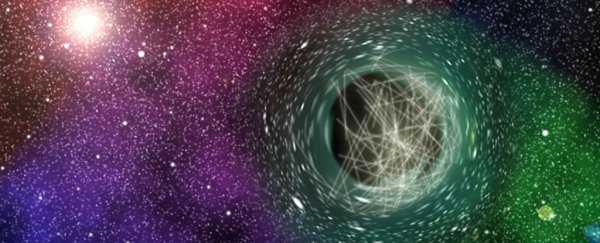You probably know that just 15 percent of the known Universe is made up of matter that we can actually see. The majority of the Universe - some 85 percent of it - is made up of dark matter and dark energy - two phenomena that are currently 100 percent unknown to science, despite the best efforts of researchers worldwide.
But now, thanks to a paper authored by over 100 physicists… well, it's still unknown, but it's just a little less unknown than it was before, because one of the top candidates for dark matter has pretty much been debunked.
The kind of matter that makes up everything we've ever seen in the Universe, from tiny quarks to massive galaxies, is only 15 percent of the matter that's actually out there. The rest is known enigmatically as dark matter, because we can't see it and no one knows what it is, but we're almost positive that it's out there, unless we have to seriously rethink our understanding of the laws of gravity - the force that governs everything in the known Universe.
There are some scientists out there doing this kind of rethinking, but most agree that dark matter has to be something. They just disagree about what that something actually is. The leading contender is a class of Weakly Interacting Massive Particles, or WIMPs. But there are other possibilities with exciting names like axions, axion-like particles, and supersymmetric particles.
Now, thanks to the Fermi Large Area Telescope, the array of possibilities is starting to thin out.
Axions were first proposed in 1977 to resolve a problem in quantum chromodynamics - the theory of how quarks interact with one another. Later, when they were developing string theory over the next 10 or 20 years, they noticed some particles showing up in it that looked a lot like axions.
Physicists are famously good at naming things, so they called these exciting new particles axion-like particles, or ALPs.
It wasn't long before they realised that axions and ALPs might also make good candidates for dark matter. When the Big Bang created all of the light and matter in the Universe, it should have also created a whole bunch of axions and ALPs - if they exist. But if they do, these particles probably would've congregated right where see evidence of dark matter.
Dark matter is hard to see - that's what makes it dark matter - so to look for it, you need to think of something clever that no one has tried before. And scientists hadn't really tried looking at gamma rays, so these researchers looked at gamma rays.
Every once in a while, you'd expect an axion or ALP to run into a bit of regular matter, which should send a gamma ray out into space with a specific energy. These gamma rays would then be visible to modern telescopes like the Fermi Large Area Telescope (LAT).
Different models of ALPs predict different numbers of them in the Universe: some models say that all of the dark matter could be ALPs, others say that they make up only a tiny fraction of it. These different models predict different amounts of gamma rays, so you can use the number and kind of gamma rays observed to test the different models of ALPs.
That's a bunch of steps, but it's exactly what a team of 102 scientists has done in a recent paper in Physical Review Letters.
They used six years of LAT data on the galaxy NGC 1275 (another very creative name), and checked to see if the observed gamma rays matched some popular models where ALPs make up about 5 percent of the dark matter in the Universe. If these ALP models were right, that would still leave 80 percent of the mass in the Universe unexplained. But you have to start somewhere with these things.
It looks like we'll have to start somewhere else. The team simulated galaxies with and without the ALPs and then they checked the results of these simulations against those six years of observations. They found that the ALPs don't seem to predict the observed gamma rays any better than the model without them.
And in science, if you have two hypotheses that perform equally well, you get rid of the one with more stuff in it. In this case, you get rid of the one with those ALPs.
There's still a big range of possibilities to explore for LAT and for future gamma-ray telescopes. The most obvious one that the researchers mention is a model where ALPs make up all dark matter, not just 5 percent of it. But testing this model is going to take some time.
So it's possible that in the next few years, we'll discover what makes up all of the dark matter in the Universe. Or we'll discover what doesn't make it up. Either way, that's pretty exciting.
